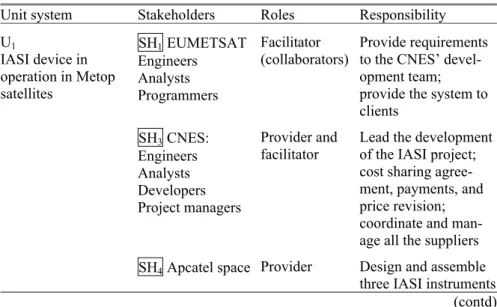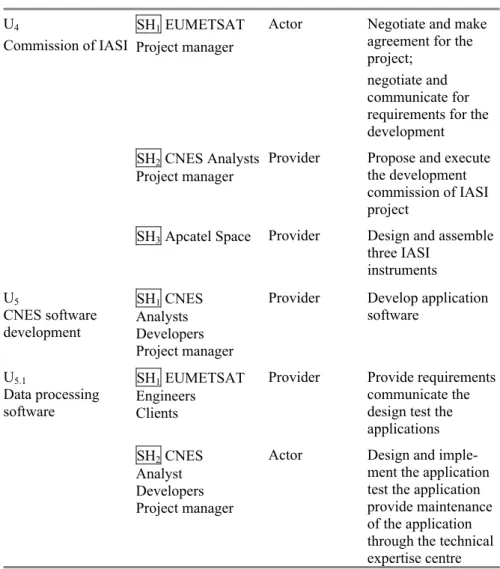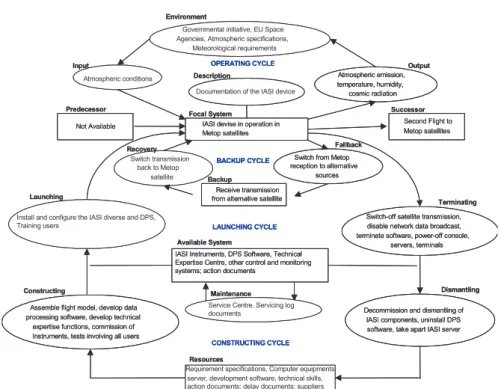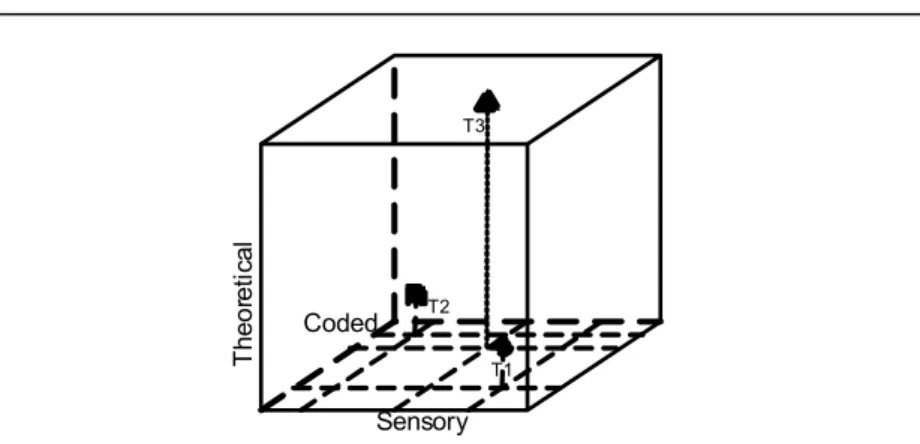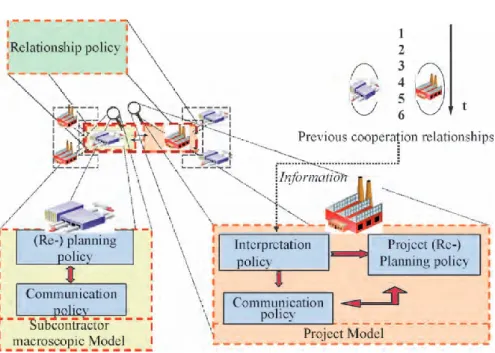As usual, all papers were discussed after their presentation and revised for the sake of the present book. It is therefore not easy to guarantee its effectiveness: this is the purpose of the project management activity.
Case 2: Risk Management and the Rosetta Project
Project risks related to (a) product performance (which is the project goal), (b–c) cost and time factors (for the project), (d) product safety. The European Space Agency's (ESA) ROSETTA mission will study the comet Churyumov Gerasimenko, which the probe will encounter in August 2014.
Management of Projects in their Early Phases
The techniques of the method, one of the OS methods, help to model the project by articulating the entire project into manageable units and linking these units with interconnected collateral relationships. This model is built on a semiotically inspired notion of point of view. An algorithm is outlined to design a cooperation policy: it relies on an iterative process that feeds and manages the simulator during the negotiation taking into account the viewpoint-centered analysis of the results of previous simulations.
Risk Management
Terminology at any given time will be understood in the context of the current state of knowledge and the associated informal culture that provides its interpretation. In the case of the Rosetta long-duration mission, it appears that the management of risks of knowledge evolution, in order to prevent uncontrolled knowledge evolution, must be based on the combination of text mining techniques and organizational arrangements.
Organizational Semiotics and Multi-Agent Paradigm
To improve this situation, organizational semiotics offers concepts for encoding the environment in the form of coping signs, social constructs and social norms. An awareness subsystem enables task switching based on emotional state and the selection of those social constructs and norms that are applicable to the current situation.
Transformation of Information
In Chapter 9, “Distinguishing Data and Information in Database Systems in the Framework of Organizational Semiotics,” Xi Wang and Junkang Feng present a semiotics-based perspective for distinguishing between data and information. The authors examine how and why the modern, seemingly confusing view of the relationship between data and information may have hindered progress on many database research questions.
Applications of Organizational Semiotics
The methodology is based (1) on the use of a discrete event-based simulator that takes into account characteristics of a cooperation policy as an input, and (2) on a model of the negotiation. This can lead to the saturation of the capacity of related agents in the MAS.
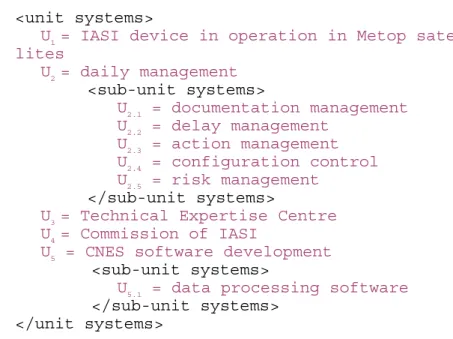
Management of Projects in their Early Phase
Using Problem Articulation Method to Assist Planning
Introduction
It is therefore essential to establish a holistic view of all units of the project, as well as interactions and communication between them. Their participation can be valued through the feedback from the stakeholders' point of view to reveal the impact and their perceived value of the project.
Articulation of Requirements of the IASI Project for Planning
- Capturing the requirements of the IASI project
- Stakeholders and their roles in the project
- A collateral structuring model for the IASI project planning
We apply the techniques of the security structuring model to visualize an integrated view of the IASI project in Fig. The safety structuring model can be used to document the entire project with the information required by the planning and management of the IASI project.
Requirements Specifications for Planning the IASI Project
The use of the PAM method has shown that the IASI project can be viewed holistically through the object systems with the associated service systems that contain the detailed level of information for the different contributing parts to the overall project, and produce the requirements. for the planning of the IASI project. Some of the information in the requirements, such as the duration and status of resource consumption, can be monitored to support project management and decision making.
Conclusions
Galarreta D (2003) Designing Spatial Systems in Multiview Semiotics, Proceedings of the 6th International Workshop on Organizational Semiotics, University of Reading, Kluwer, UK. In a more thorough review of the literature, we identify five serious shortcomings in relation to knowledge management in innovation processes, such as the difficulty in dealing with the dynamics of knowledge and the lack of consideration of task dependencies between individuals. .
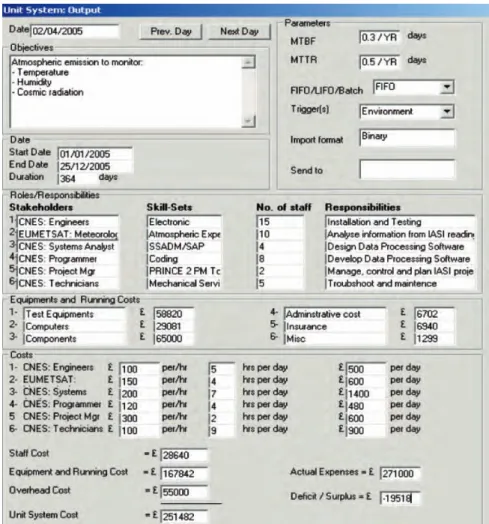
Introduction: Motive and Structure
- Motive and relevance
- Aim and structure
We wonder whether sufficient insight can be gained into the dynamics of knowledge, and thus into the innovation processes themselves, if the individual level is not the primary unit of analysis. This framework is used to manage, observe, analyze and determine knowledge in innovation processes (Cijsouw 2006).
Illustration of the Motive: 2 Case Studies
- Case study I: development of cochlear implants at 3M
- Case study II: knowledge management at British
- Highlights from the 3M and BT cases
In the conclusion (section 5), we discuss the value of the proposed new framework and refer to ongoing empirical research in medical device research (Cijsouw 2006). In the BT case study, the management of knowledge was most prominent in the composition of the development and implementation teams.
Literature review of Innovation, Project, and Knowledge
- Managing the innovation project
- Knowledge management
- Conclusion: the overlap between the two case studies
In this section, knowledge management in innovation processes is discussed from the perspective of knowledge management (literature) itself. This is due to the poor allocation of knowledge needs to tasks in the WBS.
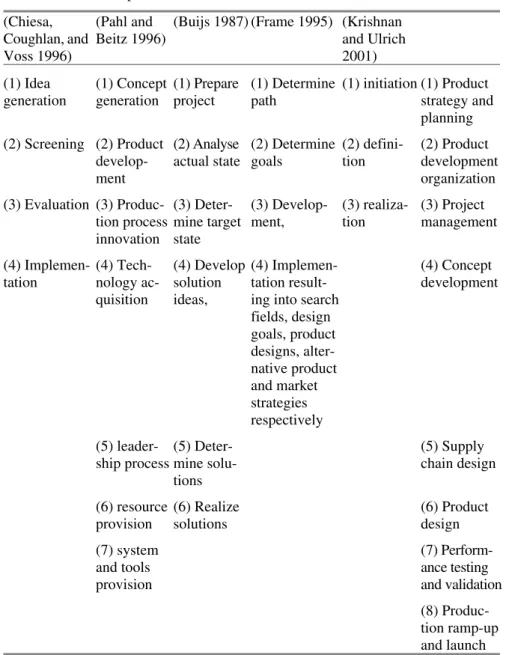
The Semio-Cognitive Framework
- The business process model
- Knowledge content classification
- Knowledge-type classification
- Example
The framework classifies types (or presentations) of knowledge along three non-orthogonal axes that form a knowledge space: sensory (ranging from rough to detailed), encoded (ranging from weak to strong), and theoretical (ranging from concrete to abstract). ) knowledge. Encoded knowledge is the group or category that is formed on the knowledge of a concrete event - sensory knowledge.
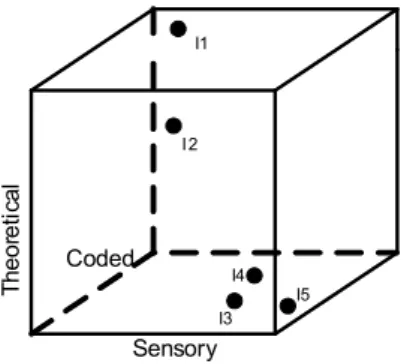
Discussion: The Framework and the Omissions
I certainly perform a semiotic enterprise, but not an action in the ordinary sense of the term. Information of signed contracts is recorded in the system information server.
Viewpoint-Centred Methodology to Design Project/
Introduction
In this chapter, we study the design of a cooperation strategy: a semiotic-based conception of point of view is used to consider the cooperation strategy as part of the information system of which the different actors of the cooperation using the simulator consist. After a state of the art (Section 3.2), we present our own analysis of the cooperation relationship within a project supply chain and the simulator built: The idea is to simulate and measure the performance of more or less cooperation policies (Section 3.3).
State of Art
Our study of the state of the art points out, on the one hand, that few studies exist on collaboration in the project supply chain, and the further design of collaboration policies within a project supply chain, although it appears to be one of the most important factors influencing the performance of the chain . In this chapter, we aim to evaluate the importance of viewpoints to design cooperation policies between actors belonging to different enterprises of a subcontractor relationship within a project supply chain.
Cooperative Subcontracting Relationship: A Simulation
- Process analysis
- A simulation tool
Then a more or less formalized dialogue starts between the two project managers in the framework of the project/subcontractor relationship. The idea is to track the evolution of the project/subcontractor relationship over a given horizon.
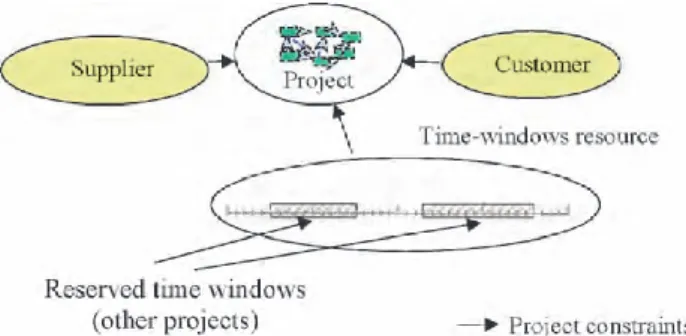
A Viewpoint-Centred Methodology to Design a Cooperation
- Viewpoint-centred designing
- Viewpoint definition
- Semiotic interpretation
- Viewpoint-centred cooperative designing process
- Cooperation policy
- Cooperation policies and viewpoint definition
- A viewpoint-centred method for cooperation
The meaning of the object is then also the result of the object design process. A point-of-view method can be defined for designing "good". participation policy and simulation tool parameter updates.
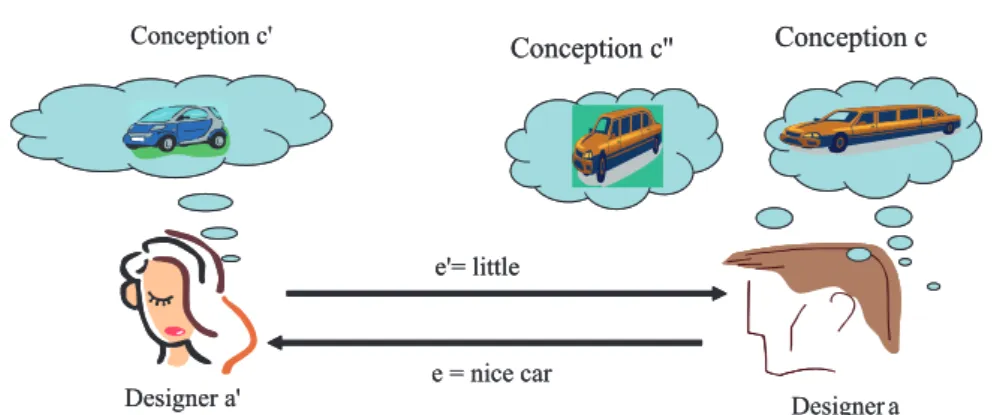
Conclusions and Future Research
Credit information of the agents plays a significant role in the coordination process in MAS. The structure of the signs refers to the pattern with which OPR interacts.
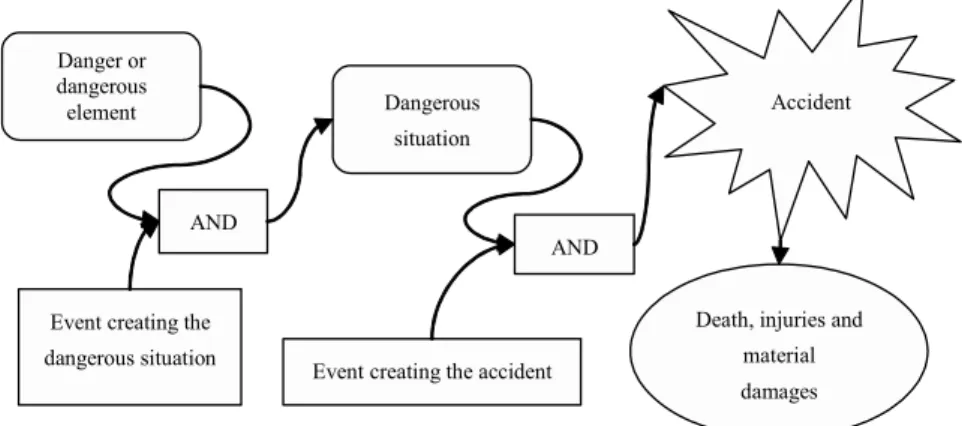
Risk Management
A Contribution to a Semiotic Approach of Risk
Introduction
- Genesis and unity of action
- Pradines’s conception of action
- A semiotic definition of action and how it relates
- We now show the consequence of this type of thought
But there is no action when a change to the outside world is not the result of a project. It is this unity of intention, of inspiration, more than the individuality of the agents, that contributes to the consequence of an action.” (ibid., p. 24).
Affordances
In this case we have to admit that a selection of actions is necessary to achieve the cultural value and meaning of the object and consequently one is forced to abandon the idea of action that we derived above. However, the application of the concept of affordability to the domain of work has led to a significant redefinition of the concept of affordability.
Affordances and Risks
The accident corresponds to the 'realization' or materialization of the risk due to human or material loss or damage (tangible or intangible)." A dangerous or threatening situation is a state of the system in the presence of danger or threat.
Risks in a Multi-Viewpoints Semiotics
This process is interpreted as identity repair (see Galarreta 2004), the object's identity: (a) being projected or (b) exhibiting an anomaly whose cause is sought, or (c) being the target of the risk analysis process . They constitute common places of the value system of truck manufacturers as well as road safety authorities.
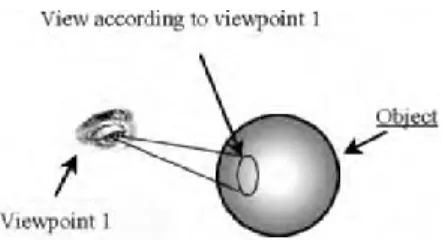
Managing Risks of Knowledge Evolution in a Long-Duration
- Rosetta: a long-duration space mission
- Managing knowledge evolutions
The knowledge we have about a technical subject is a trace of the value system in which we live. Some parts of this knowledge are related to nominal aspects of objects; other parts are associated with associated risks.
Conclusion
Organizational semiotics offers us concepts for encoding the environment in the form of affordance signs, social constructions and social norms. Second, the popping of a target results in the storage of the completed target as a declarative part.
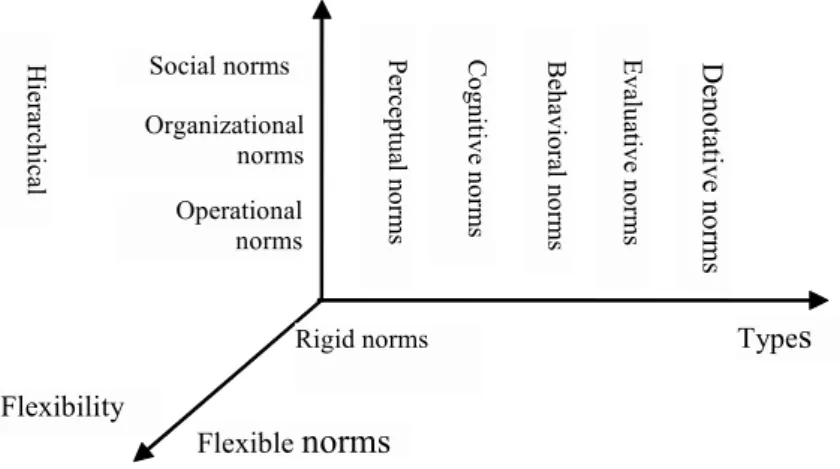
Organizational Semiotics and Multi-Agent Paradigm
Norm-Based Contract Net Protocol for Coordination
Introduction
The agent's protocols, coordination objectives, and behavioral mechanism are essential for coordination. Coordination consists of a set of mechanisms necessary for the effective operation of the MAS to obtain a balanced division of labor while reducing the logical coupling and resource dependencies of the agents.
Contract Net Protocol
In the end, the managers evaluate the bids and award contracts to the tender winners. Furthermore, the widespread notification and acceptance of messages will cause problems of message overflow and redundancy.
A Taxonomy of Norms for Norm-Based Contract Net Protocol
Therefore, in light of the above, the coordination processes in the network system cannot usually be controlled, and the effectiveness and efficiency of the coordination processes may not meet the goals and objectives of the MAS of conventional CNP. In norm-based CNP, norms are layered and classified to normalize the reasoning process of agents and satisfy different needs to improve the effectiveness and efficiency of the coordination processes.
Coordination with Norm-Based CNP
Bidder evaluation by managers includes credit information and bidders' ability to identify eligible bidders. It will lead to an improvement in the efficiency and effectiveness of the coordination process in MAS.
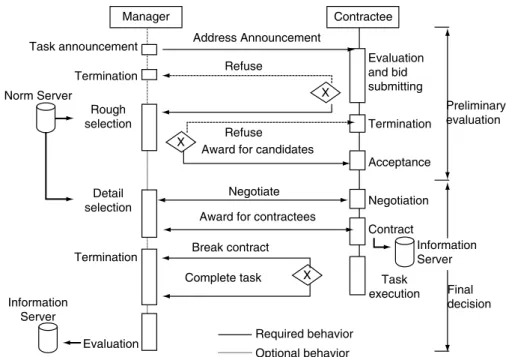
A Case Study
- Agent modelling of the enterprise
- Application of norm-based CNP to the MAS
Action and perception
Let us emphasize here "The S-R connection is between permanent entities of the environment and actions". The negotiation module controls the agent's negotiation action and monitors the agent's action in light of the negotiation protocols.
Conclusions
Isomorphism means consistency between business domain and the description (ie the model) of it in the business model. A final note on another diagram of the Riva method – the process architecture diagram – which is not analyzed here, shows the process architecture.
Interaction of Simulated Actors
Introduction
However, at the beginning of our project, ACT-R only had a single-actor implementation that could not be used for multi-actor simulations. To carry out experiments, a module has been created for collecting data and storing it in an external database.
The Use of ACT-R in a Multi-Actor Simulation
- ACT-R and Soar as cognitive architectures
- Problems of traditional cognitive architectures with
- Problems of ACT-R with social behaviour
The activation calculation apparatus is subsymbolic (neural network like), and uses 35 variables and parameters. 4 The activation of explanatory pieces is based on its previous usefulness, relevance to the general context, relevance to the specific match required, and some added noise to prevent them from getting stuck in local minima (Lebiere 2002). A problem with the use of ACT-R is its focus on behavior in Newell's cognitive band and lower rational band (10–1 to 102 sec.).10 The basic time unit of operation of ACT-R is 50 ms ( which is the default time for a production action11), while the time scale of social behavior in Newell's upper rational band and social band lies at 103–107 sec (17 min – 12 days).
Potential Solutions Offered by Organizational Semiotics
- Solutions offered by organizational semiotics
- Solutions offered by simulation of emotion
- How to improve the ACT-R actor
An affordance is a set of properties of the environment that enables or inhibits activity (Gibson 1979). More complex sign structures such as norms and social constructions can arise from the elaboration of the basic affordances.
Encoding the Environment and Body Signals
- The environment
- Affordances
- Actions enabled by affordances
- The actions of other actors
- Documents and messages
- Emotions
- Chunk types
Some types of action by the actor (b) are related to multiple objects (a) (for example, moving in a terrain with your own body towards another actor). Documents must be decoded (read and understood) by the actor before they can be encoded as ACT-R chunks.
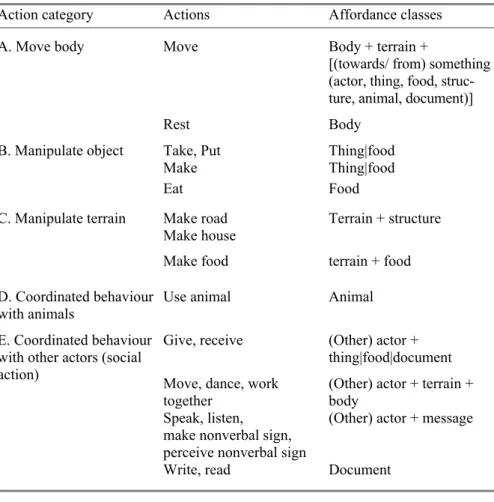
Using the Encoded Affordances, Emotions, and Norms
- Awareness
- Goal switching based on emotion
- The use of social constructs and norms
- Emotional stimulation of task performance, learning
- Learning
They will reactivate as soon as changes in emotional state make them necessary. In declarative memory, a collection of chunks is kept that represent possible actions and their direct effects on the emotional state (this could be, for example, the chunked representation of Table 2).
Conclusion
This problem will consequently cause inconsistency between the evolution of the information system and the business change. In IT model, the configuration of the set of tokens reflects components and their structure in IT domain.
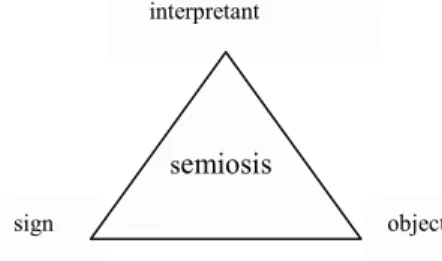
Transformation of Information
Semiotic Transformation from Business Domain to IT
Introduction
Organizational semantics, software problems, and semantic gaps are the three aspects of the semantic barrier. The semantic barriers thus reveal a gap between the developers of systems and the real world of the organization.
Literature Review
- Organizational semiotics
- Convergent architecture
The following triangle shows that the character interpreter enables the transformation between objects and characters (Peirce 1960, cited by Stamper et al. OPRs are the three key abstractions of RASC and are a verified minimal set of formal structural components through which a business model can be transformed into an IT system.
A Semiotic View of Information Systems Design
- Transformation processes of sets of signs
- Isomorphic structure for convergent architecture
When the business model is created through transformation as a set of signs (in semiosis I), it can also be seen as a set of objects (in semiosis II) in the process from business model to IT model. Finally, the set of signs (in semiosis III) in the IT domain reflects the realization of the set of objects (in semiosis I) in the business domain.
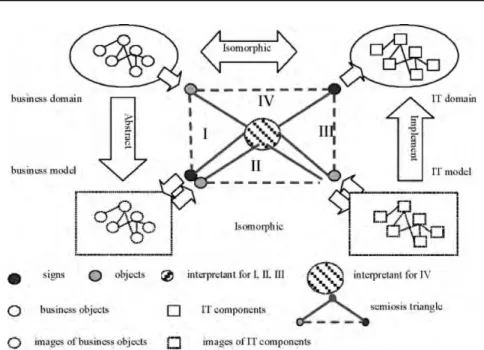
The Signs and Structure of OPR
- Loose-coupling
- Interaction of OPR
So it ties the two domains together with a token pool structure and makes components in both domains interact with each other. Rules are defined for the interaction between different token sets, which will cause the behavior of components in both fields to follow the same OPR structure without overseeing each component individually.
Realization of the Transformation Mechanism
- Norm analysis for OPR structure
- TPC and interfaces
Later, the detailed description of interfaces from business domain to IT domain with the set of characters will be achieved by using TPC reflecting the transformation mechanism. TPC is used to map business objects to IT domain through signs, which are the abstraction of the technology project.
Conclusion and Future Work
These elements are usually associated with the key concepts of the underlying theories and methodologies. Solutions to such problems include classifying paths in terms of the information content and the discriminability of a path.
Comparative Analysis of Ontology Charts
Introduction
Moreover, models can be considered as simplifications of reality, therefore it follows that by analyzing model elements we also analyze the related theories, their relevant concepts and their interpretation of reality. These methods include: Problem Articulation Methods (PAM), Semantic Analysis Method (SAM) and Norm Analysis Method (NAM) – which allow us to capture issues of a vague, complex problem, helping the problem owner to and around the common patterns of behavior to specify some of the agents in the business system (Liu 2000).
Modelling Techniques and Related Theories
- Ontology charts
- UML activity diagrams
- Role-activity diagrams (RAD)
- DIPLAN plans
- Dynamic essential modelling of organisations
It provides a time overview of the messages being exchanged. collaboration To display collaborations that include a set of roles and the required collaboration relationships. Interaction To display the different transaction types (business transactions at the type level), initiating and executing actors and the system boundary.
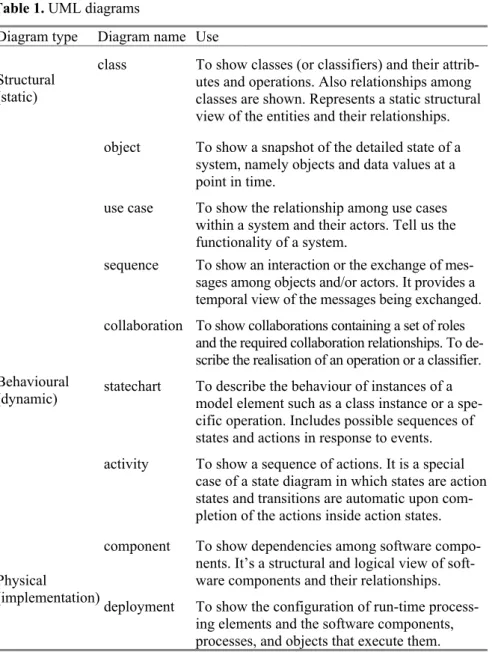
The Grocery Shop Case Study
- Case study description
- Case study model implementation
Business Process To show transaction phases, and their causal and conditional or optional relationships providing a time-aware view of business transactions. Transaction Process To show the structure of transactional communication by describing the possible communicative actions and transaction states in a business transaction process.
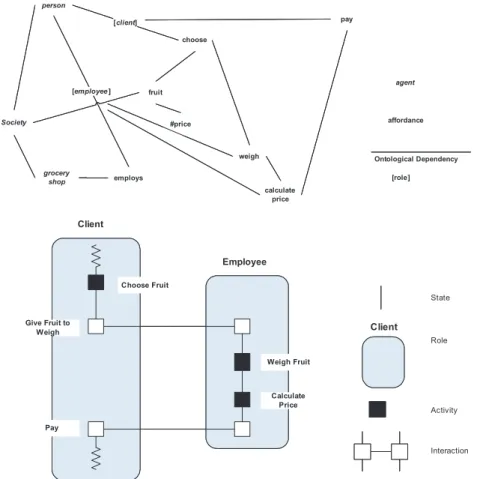
Comparative Analysis
- A comparative framework – the “common questions
- General remarks
- Ontology charts analysis
- DIPLAN analysis
- RAD analysis
- DEMO diagrams analysis
- UML analysis
An overview of the organization's functionalities, the functional dimension, is addressed only indirectly by looking at each diagram – the activity – as a whole. By giving its definition at the metal level, it is possible to change the semantics of the elements using the most powerful UML extension mechanism, the stereotype.
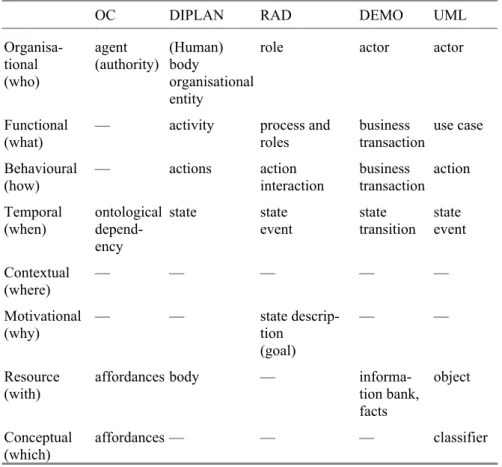
Conclusions and Future Work
We will discuss the reasons for separating data and information, and for examining the relationship between the two. We will look at how and why the contemporary, apparently confused view of the relationship between data and information may have hindered progress on a number of database research issues.
Introduction
Theoretical Foundations
Why Separating Information from Data?
- Instances do not necessarily carry the information
- Information content vs. literal/conventional meaning
- An analysis of the RIC theory
The simplest case is that the literal or conventional meaning of the data construct is part of the information content and represents what is needed. However, an example of the former is less specific than that of the latter, and therefore less informative.
Separating Data and Information Should Help
- Connection traps
- Query answering capability
- Correctness criteria for lossless transformation/translation. 173
- Summary
Conclusions and Further Work
Towards a Social-Based Process for Information
Introduction
Background
From Software Development to IS Development
- The informal IS – understanding the context of an IS
- The formal and technical IS – structuring an IS
- Discussion
Conclusion
Application of Organizational Semiotics
A Semiotic Framework for Research
Introduction
- Background
- Aims of the present chapter
The Framework and its Application
- Communication processes
- Interaction between user and networked system
- Communication relating to network (re)configuration
Multilevel Analysis and Description
- Syntactics
- Semantics
- The six-level framework
- Some benefits
Conclusion
The Semiotics of Usage-Centred Design
Introduction
Model Driven Design
Semiotic Approaches
- Peirce
- Stamper
Models as Signs
- User role model as a symbolic sign of the
- Task model as a symbolic sign spanning the application
- Content model as indexical sign of the solution
- Canonical abstract prototype as indexical sign
- Discussion
Usage-Centred Design and the Semiotic Ladder
- Social level
- Pragmatic level
- Semantic level
- Syntactic level
- Empirical level
- Physical level
- Discussion
Conclusion
